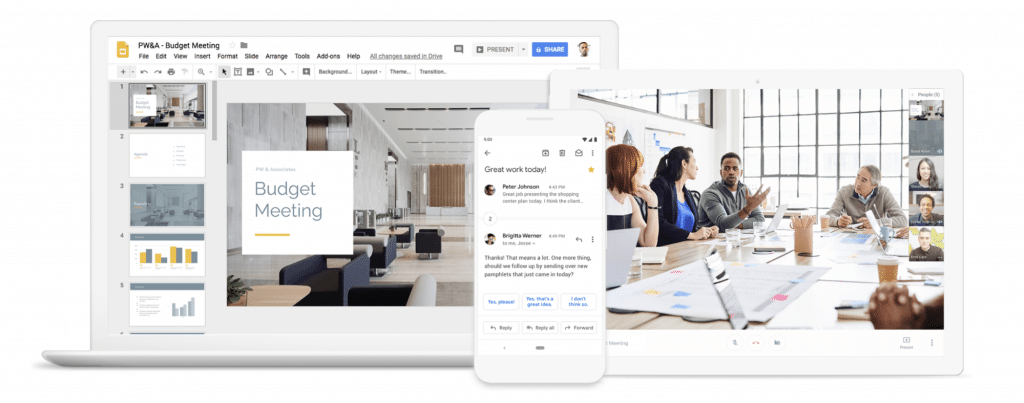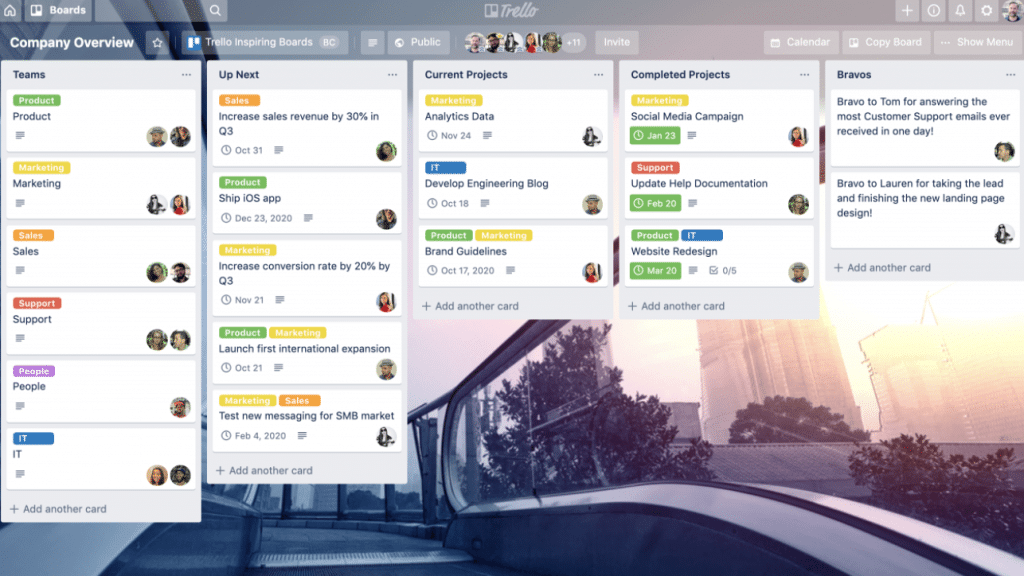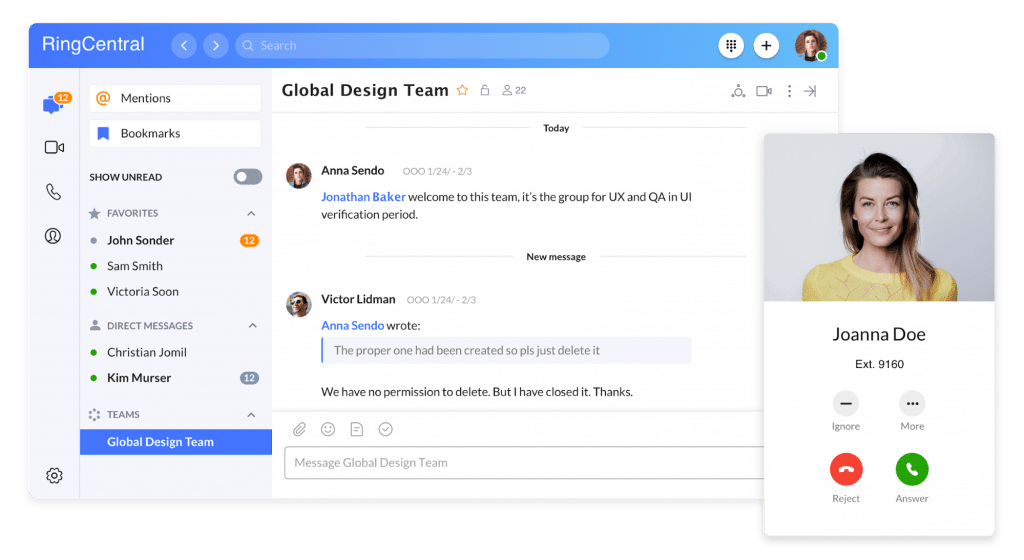Look behind any successful company and you’re likely to find a collaborative workplace culture. (Did you know that even the perception of working collectively on something can boost performance1?)
But in order to create that kind of culture, you need to actively put measures in place at your company that encourage people to collaborate. This is what’s known as “engineering collaboration.”
In this post, we’ll go through:
- What exactly “collaboration” means
- How to engineer collaboration in the workplace
- Essential tools for engineering collaboration
- 3 unique ways real-life companies have engineered collaboration
What exactly does “collaboration” mean?
Essentially, collaboration is when two or more people work together to achieve a shared goal.
You’ll often see the words “collaboration” and “cooperation” used interchangeably, but there is a difference between the two.
While collaboration involves people coming together to work on a shared task, cooperation has people working in support of another’s individual goals.
For example, a photographer and designer would work collaboratively to create a cover image. Whereas a digital consultant would cooperate with a photographer on his website portfolio, giving him advice but not actually working with him on it.
How do you “engineer collaboration” in the workplace?
If you want your team to collaborate successfully at work, you need to create the environment for it.
1. Lead by example
You can set up all sorts of strategies to cultivate a collaborative workplace, but if the company’s leaders aren’t supporting them then why would the employees?
When leaders exhibit collaborative behaviors, this will filter down to employees.
For example, a company’s culture might be one where those who ask questions or admit to not knowing something are seen as weak (or maybe even stupid). To solve this, team leaders can be the first to make themselves vulnerable by asking their own questions when they are drawing a blank or need help. Once everyone sees this, they’re likely to feel more comfortable asking questions and will become more receptive to it without judgement.
A great place to start within your company is simply how you, as a leader, interact with employees. Show them that you’re ready for dialogue, maybe through setting up one-on-ones. And if your employees are remote, try using video conferencing software like RingCentral Video, to get face-to-face time with them:
As employees become more comfortable with you, they might come to you for support. Help them out the best you can and make sure to only make promises you can keep.
These small steps will make a big difference when it comes to fostering community and collaboration.
2. Communicate clear goals and expectations
Establishing clear goals is always important, and it’s no different when it comes to designing a collaborative culture.
From the very start, make it absolutely clear who is responsible for what. Work this into the onboarding process. A team that knows their individual as well as their collective goals is one that is more likely to be productive—and less likely to suffer from a lack of communication.
You can do this in many different ways. Organization charts, internal wikis of shared team knowledge, and morning huddles to discuss the day’s goals are all great ways to communicate objectives and expectations around collaboration in the workplace.
3. Build your teams around individual strengths
When creating a culture of collaboration, it’s important to be realistic about each individual’s strengths and weaknesses.
Build teams around individuals who complement each other—with one person providing skills where another person might not be as strong.
Take the time to consider how everyone’s strengths and responsibilities fit into their roles and your collective teamwork skills.
4. Create a sense of community
Building a culture of collaboration first requires creating an environment where employees can create meaningful bonds with one another and feel comfortable communicating openly.
A few easy ways to do this would be to create spaces, both in person and virtually, where people can get to know each other on a personal level. This could be team socials, coffee pair-ups, or watercooler channels on your internal messaging platform.
It’s this sense of community that creates a safe space for people to share their ideas and contribute to solving problems.
5. Invest in the right collaboration tools
For most companies, creating a digital workplace or collaboration hub is a no-brainer when it comes to helping the team work together.
You want the strategy to come before the tech though, so take some time to think about what your needs are and which communication tools might be able to help.
Don’t feel pressured to go all-out right at the start. Try one tool and see how it works for the team. Then go from there.
Let’s look at a few helpful tools to start with.
What are the essential tools to engineer collaboration?
These days, most of a team’s collaboration takes place online. Proposals are put together by multiple people, different teams work together to solve a customer’s problem (while not always collaborating with the customer), and proofs go through rounds of edits.
These are just a few of many, many examples of collaboration in the digital workplace. And every digital workplace needs the tools to make this happen.
RingCentral
RingCentral is an all-in-one team messaging and collaboration tool that includes video calls, file sharing, task management, and loads of integrations with tools you might already be using:
You can have all your tasks in one place, attach files to each task, and instantly share those files when needed during a team video call. Your team can open files and provide immediate feedback while keeping everything organized. Handy!
Google Workspace
Chances are you’re already using one of Google’s collaboration tools, or you know someone who is.

With Google Docs, Sheets, Slides, Calendar, Drive, and Gmail, your team can collaborate on files in real time from anywhere.
Trello
Trello is a project management tool that uses boards, lists, and cards to organize tasks in a very visual way:

It’s incredibly user-friendly (hello, drag-and-drop!) and very quick to set up, making it a great option for small-to-medium-sized businesses.
3 unique ways real companies have engineered collaboration
Now that you’re up to speed on how to engineer collaboration, let’s take a look at how real companies have created more collaborative workplaces.
1. Pixar
Physical environments can make a huge difference when it comes to collaboration.
In 1999, open concept offices weren’t very common. Like most other offices, Pixar was organized by department with animators in one building, computer scientists in another, and administration in a third.
Steve Jobs, the CEO at the time, knew the potential effect an open floor plan could have on collaboration, so he decided to change the layout. He brought in a designer to create a huge central atrium with gathering spaces, theatres, and break rooms.
It worked. People who had previously been siloed were now mingling and working together in groups. Later on, Pixar’s chief creative officer said that the new space had really helped increase creativity and collaboration in the company.
2. PepsiCo
To engineer collaboration, PepsiCo handles employee bonuses a bit differently than most companies.
40% of an employee’s annual bonus is based not on their individual performance, but on how well they’ve helped other employees improve their careers.
It’s a great way to use personal rewards to encourage teamwork and foster collaboration. Employees can feel good about making meaningful bonds with colleagues, helping others, and getting rewarded for it.
3. Hilti
Every company has their own ways of team building that work for them and their employees. (Speaking of which, here are a few virtual team building activities to try.)
Construction equipment and service provider, Hilti, does what they call a “‘Culture Walk”. It works like speed dating and is meant to help teams get to know each other on a personal and professional level.
Here’s how it works. The team goes for a walk together in a two-by-two line. Each person comes to the walk prepared with four questions—two personal ones and two work-related ones.
Both people in the pair will ask and answer the questions, and after five minutes the person on the right will move up to the next person. This goes on until everyone has had a chance to speak to one another.
Something like this can work really well when it comes to engineering collaboration because not only are you creating a sense of community through the personal questions, you’re also creating new opportunities for collaboration through the work-related questions.
Are you ready to engineer collaboration at your company?
Taking the first steps to cultivate a more collaborative workplace environment can be the beginning of a happier, more creative, and more productive team.
Try a few methods, keep consistent, and you’ll soon see a difference!
1sciencedirect.com/science/article/abs/pii/S0022103114000420?via%3Dihub
Originally published Mar 16, 2020, updated Jun 07, 2024






